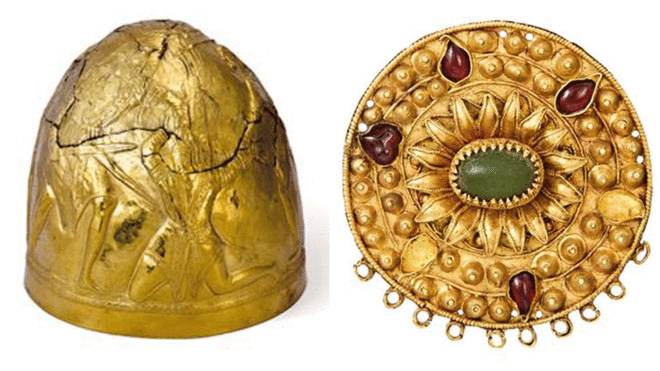Law & Politics
A Trove of Scythian Gold Was Shipped to Kyiv After Dutch Courts Rejected Crimea’s Claims to It
The ancient artifacts have been the subject of years of legal wrangling over where to return the treasures.

The ancient artifacts have been the subject of years of legal wrangling over where to return the treasures.

Devorah Lauter

Hundreds of Scythian gold artifacts from Crimean museums have been shipped to Kyiv, the culmination of a yearslong legal dispute over their possession.
The works, which were featured in a 2014 exhibition at Amsterdam’s Allard Pierson Museum, have arrived at the Museum of Historical Treasures of Ukraine, the Kyiv institution said in a statement Monday (November 27). The transfer follows a June order by the Dutch Supreme Court to ship the Scythian relics there, after it concluded the items were part of Ukraine’s national heritage, and did not belong in Russian-annexed Crimea.
Museums in Moscow-controlled Crimea have been disputing that claim in Dutch courts for nearly a decade, arguing any failure to return the gilded jewels lent from four Crimean institutions violated their loan agreement.
The “Scythian gold,” as it is often called, “belongs to Crimea and must be there,” Kremlin spokesman Dmitry S. Peskov told reporters at a Monday press conference, according to the Russian media outlet Interfax.
The items include a solid gold Scythian helmet from the fourth century B.C., ceremonial daggers, Scythian and Sarmatian jewelry, and Chinese lacquer caskets, some as old as 2,000 years.
But the Dutch court sided with Ukraine, asserting Crimea is part of its internationally recognized “territorial integrity,” and upheld a lower court’s 2021 ruling to hand the collection to Ukraine. “Although the museum pieces originate from Crimea and can therefore also be regarded as Crimean heritage, they are part of the cultural heritage of Ukraine,” the court said.
The outcome in the protrtacted legal battle is symbolically significant as well. In the years since Russia invaded Crimea in 2014, the dispute had come to emblematize the violent territorial disputes between the two nations—a matter that obviously escalated dramatically in 2022, when Russia launched a full-scale invasion of Ukraine.
When the exhibition called “Crimea: Gold and Secrets of the Black Sea” closed at the Allard Pierson Museum in late 2014, following Moscow’s annexation of Crimea, the institution did not know where to send the loaned items, so it took the matter to court in what became a decade-long legal process.
The artifacts, “cannot be returned to Crimea for an obvious reason—it cannot be given to the occupier, the robber,” said Ukrainian President Volodymyr Zelensky in a tweet praising the court’s decision in June. “Of course, it will be in Crimea—when the Ukrainian flag will be in Crimea,” he added.
The four Crimean museums claiming rightful ownership include the Kerch Historical and Archaeological Reserve, the Central Museum of Taurida, the Bakhchisarai Historical and Cultural Reserve, and the National Reserve Khersones Tavriyskyi.
The Ukrainian National History Museum said its workers have been carefully unpacking 565 of the contested pieces, which arrived by truck after years of languishing in storage, on Sunday. “The museum will make every effort to preserve [the artifacts],” Fedir Androschuk, director of the institution, said in the statement, adding “all those who were behind the political decision to return the collection to warring Ukraine,” had a special responsibility to “provide it with unprecedented protection.”
The museum also reiterated that the items would be “kept until the deoccupation of Crimea.”
More Trending Stories:
How an Exclusive NYC Cult Influenced the 1970’s Art Scene
A Rare Soulages Lithograph Possibly Worth $30,000 Sells For $130 in Facebook Marketplace Mishap
Masterpiece or Hot Mess? Here Are 7 Bad Paintings by Famous Artists
Is There a Hat Better Than Napoleon’s? We Rank Art History’s 5 Most Iconic Chapeaux